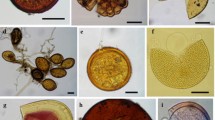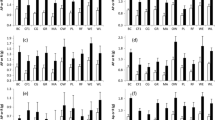Abstract
The arbuscular mycorrhizal (AM) morphology of three host plant species inoculated with single and mixed fungal culture and the distribution of AM fungal species in roots of the hosts treated with a mixed culture of AM fungi were determined. The aim was to investigate the effect of host plants and AM fungi on AM morphology of coexisting plant species. Noncolonized rooted cuttings of Hedera rhombea (Miq) Bean, Rubus parvifolius L., and Rosa multiflora Thunb. were inoculated with five fungal species as single and mixed culture inocula. The fungal species used were Gigaspora rosea and Scutellospora erythropa, previously isolated from H. rhombea; Acaulospora longula and Glomus etunicatum from R. parvifolius; and Glomus claroideum from both plant species. A few hyphal and arbusculate coils were seen in the mixed culture-inoculated roots of R. parvifolius; all fungal treatments produced this Paris-type AM in H. rhombea and Arum-type AM in R. parvifolius, and R. multiflora indicates that AM morphology is strongly controlled by the identity of the host plants used in this study. AM fungal rDNA was extracted separately from roots of each replicate plant species inoculated with the mixed fungal culture, amplified, cloned, sequenced, and analyzed to determine the AM fungal species and their respective proportions in roots of each plant species. Glomus etunicatum and G. claroideum of the family Glomaceae generally occurred more frequently in R. parvifolius and R. multiflora, which form Arum-types, whereas S. erythropa, of the family Gigasporaceae, was the most frequently detected species in H. rhombea, which produced Paris-type AM. Although the genotype of the plant species used appears to determine the AM morphologies formed, there was preferential association between the hosts and AM fungal inoculants.



Similar content being viewed by others
References
Adjoud D, Plenchette C, Halli-Hargas R, Lapeyrie F (1996) Response of 11 eucalyptus species to inoculation with three arbuscular mycorrhizal fungi. Mycorrhiza 6:129–135
Ahulu EM, Nakata M, Nonaka M (2005) Arum- and Paris-type arbuscular mycorrhizas in a mixed pine forest on sand dune soil in Niigata Prefecture, central Honshu, Japan. Mycorrhiza 15:129–136
Ahulu EM, Gollotte A, Gianinazzi-Pearson V, Nonaka M (2006) Co-occurring plants forming distinct arbuscular mycorrhizal morphologies harbour similar AM fungal species. Mycorrhiza (in press)
Bedini S, Maremmani A, Giovannetti M (2000) Paris-type mycorrhizas in Smilax aspera L. growing in a Mediterranean sclerophyllous wood. Mycorrhiza 10(1):9–13
Bever JD, Morton JB, Antonovics A, Schultz PA (1996) Host-dependent sporulation and species diversity of arbuscular mycorrhizal fungi in mown grassland. J Ecol 84:71–82
Bidartondo MI, Redecker D, Hijri I, Wiemken A, Bruns TD, Dominguez L, Sercic A, Leake JR, Read DJ (2002) Epiparasitic plants specialized on arbuscular mycorrhizal fungi. Nature 419:389–392
Bonfante-Fasolo P, Fontana A (1985) VAM fungi in Ginkgo biloba roots: their interactions at the cellular level. Symbiosis 1:53–67
Brundrett MC, Kendrick WB (1990a) The roots and mycorrhizae of herbaceous woodland plants. I. Quantitative aspects of morphology. New Phytol 114:457–468
Brundrett MC, Kendrick WB (1990b) The roots and mycorrhizae of herbaceous woodland plants. II. Structural aspects of morphology. New Phytol 114:469–479
Cavagnaro TR, Gao L-L, Smith FA, Smith SE (2001) Morphology of arbuscular mycorrhiza is influenced by fungal identity. New Phytol 151:469–475
Clapp JP, Young JPW, Merryweather JW, Fitter AH (1995) Diversity of fungal symbionts in arbuscular mycorrhizas from a natural community. New Phytol 130:259–265
Dickson S (2004) The Arum–Paris continuum of mycorrhizal symbioses. New Phytol 1631:187–200
Eom AH, Hartnet DC, Wilson GWT (2000) Host plant species effects on arbuscular mycorrhizal fungal communities in tallgrass prairie. Oecologia 122:435–444
Gollotte A, van Tuinen D, Atkinson D (2004) Diversity of mycorrhizal fungi colonizing roots of grass species Agrostis capillaries and Lolium perenne in a field experiment. Mycorrhiza 14:111–117
Hart MM, Richard RJ (2002) Taxonomic basis for variation in the colonization strategy of arbuscular mycorrhizal fungi. New Phytol 153(2):335–344
Helgason T, Fitter AH, Young JPW (1999) Molecular diversity of arbuscular mycorhhizal fungi colonizing Hyacinthoides non-scripta (bluebell) in seminatural woodland. Mol Ecol 8:659–666
Imhof S, Weber HC (1997) Root anatomy and mycotrophy (AM) of the achlorophyllous Voyria truncata (Stanley) Stanley and Steyermark (Gentianaceae). Bot Acta 110:127–134
Imhof S, Weber HC (2000) Root structures and mycorrhiza of the achlorophyllous Voyria obconica progel (Gentianaceae). Symbiosis 29:201–211
Jacquelinet-Jeanmougin S, Gianinazzi-Pearson V (1983) Endomycorrhizas in Gentianaceae. I. The fungus associated with Gentiana lutea L. New Phytol 95:663–666
Johnson D, Vandenkoornhuyse P, Leake JR, Gilbert L, Booth RE, Grime JP, Young JPW, Read DJ (2003) Plant communities affect arbuscular mycorrhizal fungal diversity and community composition in grassland microcosms. New Phytol 161:503–515
Karandashov V, Nagy R, Wegmüller S, Amrhein N, Bucher M (2004) Evolutionary conservation of a phosphate transporter in the arbuscular mycorrhizal symbiosis. Proc Natl Acad Sci USA 101:6285–6290
Kjøller R, Rosendahl S (2001) Molecular diversity of glomalean (arbuscular mycorrhizal) fungi determined as distinct Glomus specific DNA sequences from roots of field grown peas. Mycol Res 105:1027–1032
Kubota M, McGonigle TP, Hyakumachi M (2005) Co-occurrence of Arum- and Paris-type morphologies of arbuscular mycorrhizae in cucumber and tomato. Mycorrhiza 15:73–77
Landis FC, Gargas A, Givnish TJ (2004) Relationships among arbuscular mycorrhizal fungi, vascular plants and environmental conditions in oak savannas. New Phytol 164:493–504
Lovelock CE, Ewel JJ (2005) Links between tree species, symbiotic fungal diversity and ecosystem functioning in simplified tropical ecosystems. New Phytol 167:219–228
Schüßler A, Geherig H, Schwarzott D, Walker C (2001) Analysis of partial Glomales SSU rRNA gene sequences: implications for primer design and phylogeny. Mycol Res 105:5–15
Smith SE, Read DJ (1997) Mycorrhizal symbiosis, 2nd edn. Academic, London
Smith FA, Smith SE (1997) Structural diversity in (vesicular)-arbuscular mycorrhizal symbioses. New Phytol 137:373–388
Streitwolf-Engel R, Boller T, Wiemken A, Sanders IR (1997) Clonal growth traits of two Prunella species are determined by co-occurring arbuscular mycorrhizal fungi from a calcareous grassland. J Ecol 85:181–191
Stukenbrock EH, Rosendahl S (2005) Clonal diversity and population genetic structure of arbuscular mycorrhizal fungi (Glomus spp.) studied by multilocus genotyping of single spores. Mol Ecol 14:743–752
Trouvelot A, Kough JL, Gianinazzi-Pearson V (1986) Mesure du taux de mycorhization VA d’un système radiculaire. Recherche de méthodes d’estimation ayant une signification fonctionnelle. In: Gianinazzi-Pearson V, Gianinazzi S (eds) Physiological and genetical aspects of mycorrhizae. INRA, Paris, pp 217–221
Trouvelot S, van Tuinen D, Hijiri M, Gianinazzi-Pearson V (1999) Visualization of ribosomal DNA loci in spore interphasic nuclei of Glomalean fungi by fluorescence in situ hybridization. Mycorrhiza 8:203–206
Van Aarle IM, Cavagnaro TR, Smith SE, Smith FA, Dickson S (2005) Metabolic activity of Glomus intraradices in Arum- and Paris-type arbuscular mycorrhizal colonization. New Phytol 166(2):611–618
Van der Heijden MGA, Boller T, Wiemken A, Sanders IR (1998) Different arbuscular mycorrhizal fungal species are potential determinants of plant community structure. Ecology 79:2082–2091
Vandenkoornhuyse P, Husband R, Daniel TJ, Watson IJ, Duck JM, Fitter AH, Young PW (2002) Arbuscular mycorrhizal community composition associated with two plant species in a grassland ecosystem. Mol Ecol 11:1555–1564
Vandenkoornhuyse P, Ridgway KP, Watson IJ, Fitter AH, Young JPW (2003) Co-existing grass species have distinctive arbuscular mycorrhizal communities. Mol Ecol 12:3085–3095
van Tuinen D, Jacquot E, Zhao B, Gollotte A, Gianinazzi-Pearson V (1998) Characterization of root colonization profiles by a microcosm community of arbuscular mycorrhizal fungi using 25S rDNA-targeted nested PCR. Mol Ecol 7:879–887
Yamato M, Iwasaki M (2002) Morphological types of arbuscular mycorrhizal fungi in roots of understorey plants in Japanese deciduous broadleaved forests. Mycorrhiza 12:291–296
Author information
Authors and Affiliations
Corresponding author
Rights and permissions
About this article
Cite this article
Matekwor Ahulu, E., Andoh, H. & Nonaka, M. Host-related variability in arbuscular mycorrhizal fungal structures in roots of Hedera rhombea, Rubus parvifolius, and Rosa multiflora under controlled conditions. Mycorrhiza 17, 93–101 (2007). https://doi.org/10.1007/s00572-006-0080-7
Received:
Accepted:
Published:
Issue Date:
DOI: https://doi.org/10.1007/s00572-006-0080-7




